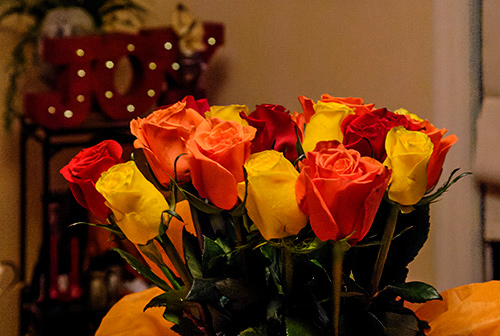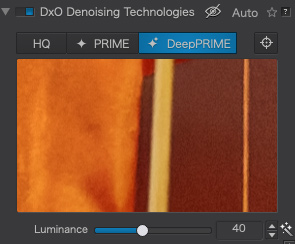C O N T E N T S
•
Photo Corners headlinesarchivemikepasini.com
![]()
A S C R A P B O O K O F S O L U T I O N S F O R T H E P H O T O G R A P H E R
![]()
Enhancing the enjoyment of taking pictures with news that matters, features that entertain and images that delight. Published frequently.
Going Deep Into DxO DeepPRIME



30 December 2020
In our October review of PhotoLab 4, we listed DeepPRIME as the top highlight for a reason. After training the denoising and demosaicing tool with "several billion samples" from DxO's comprehensive database of cameras and lenses, it promised to give our older digital images a facelift.

Roses. This is the final image (details below) that profits from the pixel binning of reducing the image size, too.
That's no small thing. The sensors in older digital cameras struggled with noise, especially in the darker areas of the image. And that struggle often began at sensitivities as low as ISO 400.
The grainy texture that resulted wasn't particularly attractive nor very stylish. And many of those images were left in the archive untouched as a result.

But DxO has for many years collected data on nearly every digital camera and lens combination ever produced. By using that data to train DeepPRIME, the company created a unique and powerful tool for older images.
In our review we showed a tiny example of the tool with its preview, reproduced here for your convenience.
But we wanted to give it a more thorough test.
A TEST IMAGE
Nothing against the test images that proliferate on review sites, but we like to get in genuine trouble with our shots and see how image editing software rescues us. We're good at getting into trouble.
And we got in trouble with the shot you see above in its final form.
It's a halogen light source to being with taken with a Nikon D200 from 2005 (that's a 15-year-old camera) using a 43-86mm Nikkor from the 1970s (which makes it a 50-year-old optic). It was shot at f5.6 for 1/25 second at ISO 1600, as high as the D200 gets.
But we liked the roses and wanted to capture them that night in particular.
So we focused the lens and took the shot as a Raw image which we subsequently converted to DNG and processed in both Adobe Camera Raw and DxO PhotoLab 4.
THE EDIT
We made equivalent basic edits to both images. And we downsized the image to 500 pixels wide for a blog entry we had written. That reduced the size of the image from 3351 pixels to 500 pixels, which is sufficient pixel binning or combining to average out the noise.
We expected the full size image to look better with DeepPRIME. But the DxO image looked remarkably better even at the reduced image size.
WHAT'S GOING ON
So what was going on?
The first thing to appreciate is that DxO knows all about the D200's sensor. And it knows nothing at all about the 43-86mm Nikkor.
That means we probably gave up some optical corrections but as far as demosaicing and denoising go, DeepPRIME was familiar with the D200's characteristics.
The second thing to appreciate is that the tool is doing demosaicing not just denoising. So we were going to get a better tonal and color rendering from the Raw data.
And the third thing to appreciate is that we were using Raw data. DeepPRIME doesn't work on JPEGs.
THE RESULT
Here at last are the two 100-percent crops of the renderings before resizing. See for yourself the dramatic different DeepPRIME made.
And here's a comparison between the two 500-pixel reductions, both done in Photoshop:
There's a slight distortion caused by the perspective control applied independently, which we couldn't avoid. And the variation in tone and color is also unavoidable as we worked on each image independently.
At 500 pixels, there are aspects of each we like. The yellow roses have more detail in the Adobe Camera Raw version but the darker flowers are more luminous in the DxO version.
There's no getting around the difference in noise reduction at 100 percent, though.
CONCLUSION
By informing its demosaicing and denoising operations with its extensive database of sensor and lens characteristics, DeepPRIME affords significantly improved image quality for images taken with older sensors even if the lens used is too old to have been cataloged.
Tone, color and noise are all noticeably improved rendering the Raw data with DeepPRIME, providing an improved starting point from which to make further edits.
Now, if you'll excuse us, we have about 50,000 images to reprocess.